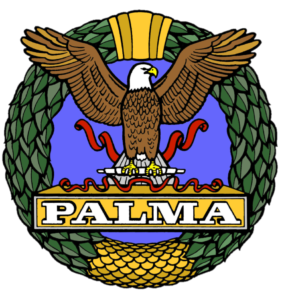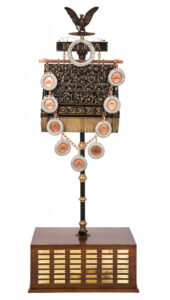
History of the Palma Match
The Palma competition originated in 1876 as part of the centennial celebration of American independence. This “Great Centennial Rifle Match” was held at Creedmoor, the long distance shooting range on Long Island, and hosted by a very young National Rifle Association (charted in 1871). Teams from the United States, Australia, Canada, Scotland and Ireland competed in this inaugural competition. Then, each team consisted of eight firing members each shooting 15 shots each at 800, 900, and 1000 yards on a six by ten foot frame target with a 36 inch black bull’s eye. The United States won that match.
The match is named after the trophy, the Palma, awarded to the victorious team. The trophy was custom-built by Tiffany’s of New York at a cost of $1500 (privately funded) and included 280 ounces of silver. The trophy stood seven and one-half feet tall and was modeled after a Roman legion’s standard with an eagle perched on a panel with the word PALMA – Latin for victory, honor, glory – inscribed on it. 
The Match is the world’s second-oldest international team match, behind only the America’s Cup (founded 1851). Originally intended to be an annual competition, the Palma trophy was contested intermittently into the late 1920s. The competition was revived in the modern era in 1966 in Canada and is now the culminating event of the Target Rifle (TR) World Long Range Championships (WLRC). The Long Range Team Championship Match is the formal name, but as long as the United States is competing in this match, it is known as the Palma Team Match. The match format remains 15 shots by each team member at each distance – 800, 900, and 1000 yards, or the metric equivalent, but is now fired twice over two consecutive days by teams of 16 firers occupying 4 targets. Thus, for the WLRC, a full strength Palma ‘Squad’ is 25 persons: a Captain, an Adjutant, 4 target Wind Coaches, a main Wind Coach, 16 Firers, and 2 Reserves. The Palma Trophy is awarded to the winner of this Long Range Team match.
The original trophy was last seen in the early 1930’s in what is now the Old Executive Office building – next door to the White House, but extensive searches over the decades have proven futile. However, the original Tiffany plans for the trophy were found, and Dr. Herbert M. Aitken, M.D, from Eau Claire, WI, constructed a two-third size replica of the Palma Trophy. He donated it to the NRA in 1988.
For a summary of Palma Match results see here.